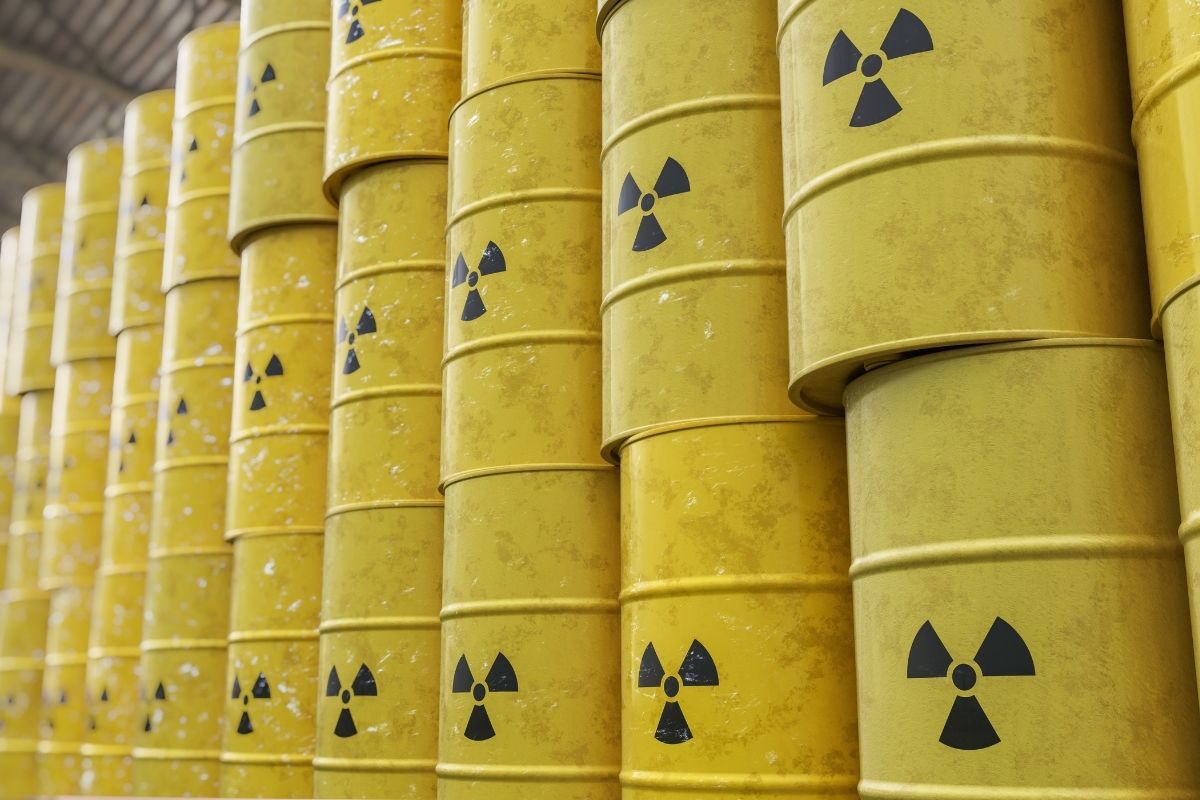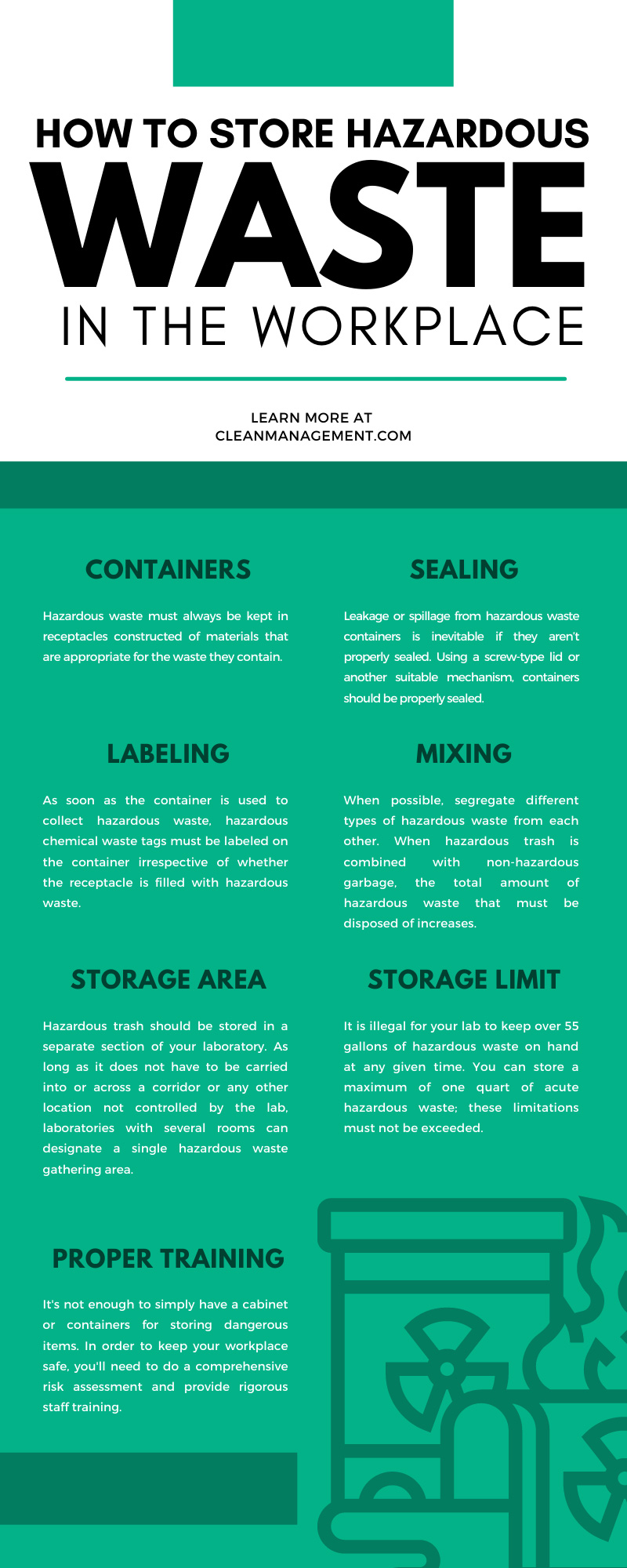How To Store Hazardous Waste in the Workplace

When you’re storing hazardous waste, you must keep a lot of things in mind. You have to figure out exactly how and where to store the waste itself, as well as what types of containers it should go in. The storage of hazardous waste may sound like it’s pretty straightforward, but with all of the red tape and regulations, it’s easy for things to get lost in the shuffle. In instances like this, it’s a good idea to get a refresher. Take a look at this guide on how to store hazardous waste in the workplace.
What is Waste?
Waste is anything that’s thrown away, disposed of, burned, incinerated, or recycled. It can be solid, liquid, or gaseous. Even recyclable or reusable products—such as solvents used for fuel—may be deemed waste. A waste becomes hazardous when it’s detrimental to human health or the environment or determined by the EPA to be dangerous.
Containers
Hazardous waste must always be kept in receptacles constructed of materials that are appropriate for the waste they contain. Containers used to store hazardous material must be free of leaks and exterior residue. Containers used for household detergent or those in the foodservice industry are unacceptable for use. It’s preferable to use the original chemical receptacle for hazardous waste disposal.
Sealing
Leakage or spillage from hazardous waste containers is inevitable if they aren’t properly sealed. Using a screw-type lid or another suitable mechanism, containers should be properly sealed. The use of improvised covers such as aluminum foil or plastic wrap is prohibited. When not adding or removing garbage, a container storing hazardous waste must be sealed at all times.
Labeling
As soon as the container is used to collect hazardous waste, hazardous chemical waste tags must be labeled on the container irrespective of whether the receptacle is filled with hazardous waste. The laboratory has to supply a variety of details on the tags, including the person’s name, phone number, address, and room number. When the container is full, enter the date in the appropriate field.
Information on the contents of the hazardous waste receptacle should be provided, including proportions and water content if available. This will make disposal easier and faster. A tag should be filled out as soon as the container is used to store hazardous trash, and it must be modified when more garbage is collected. Each container of hazardous trash must have its own tag attached to it. Old labels that don’t correctly reflect the contents of the waste container must be defaced.
Mixing
When possible, segregate different types of hazardous waste from each other. When hazardous trash is combined with non-hazardous garbage, the total amount of hazardous waste that must be disposed of increases. Combining hazardous wastes might raise disposal costs since different hazardous wastes have different disposal strategies. This may be the most important point in storing hazardous waste in the workplace because recklessly throwing different substances together can spell disaster.
Storage Area
Hazardous trash should be stored in a separate section of your laboratory. As long as it does not have to be carried into or across a corridor or any other location not controlled by the lab, laboratories with several rooms can designate a single hazardous waste gathering area. Secondary containment is required for hazardous waste storage to ensure that spills don’t reach the sinks, vent, or floor drains and cause damage. Incompatible hazardous substances must be separated to avoid reactions. For segregation, use separate cabinets, hoods, or supplementary containment containers such as five-gallon buckets or tubs. Safely storing hazardous waste is an easy approach to safeguard the health of your community.
Store hazardous waste receptacles off the floor, in containers, and out of the elements. As a result, no leaks will happen. The containers will also be protected against environmental deterioration. The waste should be kept in a secure location where the general public won’t be able to access it. Properly prepare and handle your garbage before you store it.
When you’re storing flammable hazardous materials, take every precaution to avoid a fire, explosion, or leak. Closed containers should be used to store these compounds away from ignition sources and other potentially hazardous materials. Keep combustible chemicals in locations with enough ventilation to help disperse leaks and spills as quickly as possible. The storage area must also be fire-resistant and made of incombustible materials.
Storage Limit
It is illegal for your lab to keep over 55 gallons of hazardous waste on hand at any given time. You can store a maximum of one quart of acute hazardous waste; these limitations must not be exceeded. Your hazardous and acute hazardous trash will get collected at regular intervals. When you’re planning your storage area, don’t forget to take your storage capacity into account. Secondary containment and compatibility segregation are required for hazardous waste storage in order to reduce the danger of spills.
Hazardous waste must not be kept in quantities that make it impossible to follow safe storage procedures. Calculate the amount of hazardous waste that’ll build in your storage space before it’s collected. This calculation should be based on the rate at which your laboratory generates hazardous waste, your storage capacity, and the quantity restrictions stated above. Hazardous material should be stored as little as possible in laboratories. When it comes time to dispose of these materials in your storage, hire specialized waste disposal services to make sure the job is done right.
Proper Training
It’s not enough to simply have a cabinet or containers for storing dangerous items. In order to keep your workplace safe, you’ll need to do a comprehensive risk assessment and provide rigorous staff training. Risk assessments aid in the identification of hazardous materials and the understanding of the hazards associated with them. Good training makes sure employees know to take the time to safely store, transfer, and handle the chemicals. As a part of their training, employees should be taught how to perform visual inspections and detect early warning indications of possible problems. If any racks or labels are damaged, they must get repaired right away. Any evidence of damaged storage containers should get documented.

